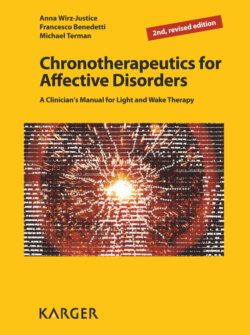Читать книгу Chronotherapeutics for Affective Disorders - M. Terman - Страница 18
На сайте Литреса книга снята с продажи.
1.8 Light Therapy – Beyond SAD
ОглавлениеDaniel Kripke was the pioneer who proposed and tested light therapy for non-seasonal depression [34, 35], but it is only now, more than 30 years later, that there are adequately controlled longer-term studies to support his predictions.
Table 3. Features of winter seasonal affective disorder*
| • Two or more consecutive episodes of major depression in autumn or winter • Spontaneous remission in spring or summer • Atypical neurovegetative symptoms – Daytime sleepiness – Increased sleep need/hypersomnia – Increased appetite – Carbohydrate craving – Weight gain |
| * DSM-IV criteria do not specify atypical symptoms. |
A new generation of clinical trials has begun to establish the therapeutic efficacy of light for a variety of psychiatric disorders [32, 36]. Double-blind, placebo-controlled studies show that light therapy combined with an SSRI leads to more rapid (within a week) and more profound (by approximately 30%) improvement in patients with non-seasonal major depression [37, 38]. The need for efficacious treatment of depression during pregnancy without side effects for the foetus has led to trials of monotherapy with light [40, 41]. Bulimic patients also respond to light with improvement of both depressive and bulimic symptoms [42, 43]. Light is useful in improving sleep, mood and cognition in dementia [44-46]. Most impressively, treatment of chronic depression (greater than 2 years’ duration) with light has yielded good results in this often treatment-resistant group [47]. Even core symptoms of the burnout syndrome may respond to light [48].
Fig. 11. Weekly depression self-ratings in a female SAD patient over 4 years (6 = threshold for depressive mood). Her winter depression episode began regularly in October. The first year illustrates the untreated natural course of the illness, with maximum depression ratings in December and January, declining to normal values in April. Light therapy begun in January of the second year induced a lasting euthymia. In year 3, light therapy began earlier, thus cutting off most of the depressive episode until the spontaneous remission in April. Note that stopping light treatment in March resulted in a return of minor symptoms. This is even more clearly seen in year 4, underlining the strongly seasonal nature of the illness. From Wirz-Justice and Staedt [39], with permission.
Table 4. Promising indications for light therapy
| • SAD • Sub-syndromal SAD • Non-seasonal recurrent depression • Bipolar depression • Chronic depression • Premenstrual dysphoric disorder • Antepartum depression • Attention deficit/hyperactivity disorder • Chronic fatigue syndrome • Schizophrenia • Borderline personality disorder • Parkinson’s disease • Alzheimer’s disease, mild cognitive impairment • Circadian rhythm sleep disorders (advanced and delayed sleep phase disorder, irregular sleep-wake cycles) |
Thus, light is emerging as a broad-spectrum antidepressant ‘drug’, with an effect size equal to or better than medication, and the ability to shorten the latency to response. Even though evidence continues to accumulate in ongoing clinical trials, there is sufficient strong support for the use of light therapy for affective disorders independent of diagnostic subgroup [28-30, 32, 36].
Fig. 12. Depression self-ratings every 2 h during wakefulness in a female bipolar patient whose sleep was phase advanced by 6 h to begin at 5 p.m. Over 3 weeks, overall mood rose, remained stable for a certain period, and then declined. The diurnal variation of mood showed every possible pattern during this time: no mood swings during the deepest depression and when euthymic, improvement beginning in the evening with morning lows, relapse beginning in the evening with morning well-being. From Wirz-Justice and Van den Hoofdakker [24], with permission.
The potential scope for light therapy extends far beyond narrowly defined major depressive and bipolar disorders. Table 4 lists established and exploratory applications that are showing promise.
